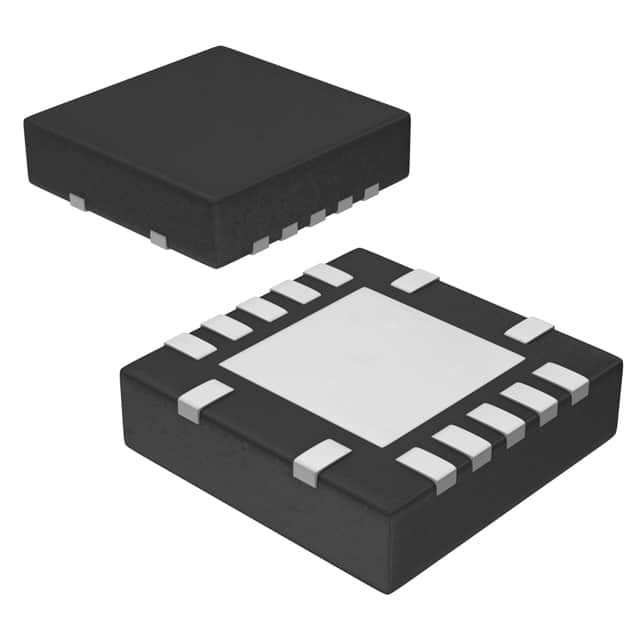Viz Specifikace pro podrobnosti o produktu.

SN74CB3T3125RGYR
Product Overview
Category
SN74CB3T3125RGYR belongs to the category of integrated circuits (ICs).
Use
This product is commonly used for signal switching applications in electronic devices.
Characteristics
- Low power consumption
- High-speed switching capability
- Wide operating voltage range
- Compact size
Package
SN74CB3T3125RGYR is available in a small outline package (SOP) with a specific pin configuration.
Essence
The essence of this product lies in its ability to efficiently switch signals within electronic circuits.
Packaging/Quantity
SN74CB3T3125RGYR is typically packaged in reels or tubes, and the quantity per package varies depending on the manufacturer.
Specifications
- Supply Voltage: 1.65V to 5.5V
- Operating Temperature Range: -40°C to +85°C
- Number of Channels: 4
- On-State Resistance: 5Ω (typical)
- Maximum Data Rate: 400Mbps
Detailed Pin Configuration
The pin configuration of SN74CB3T3125RGYR is as follows:
___________
OE | 1 16 | VCC
A1 | 2 15 | B1
A2 | 3 14 | B2
A3 | 4 13 | B3
GND | 5 12 | B4
Y1 | 6 11 | OE#
Y2 | 7 10 | A4
Y3 | 8 9 | A4
‾‾‾‾‾‾‾‾‾‾‾
Functional Features
- Bidirectional signal switching
- High-speed data transmission
- Low power consumption
- ESD protection
- Wide operating voltage range
Advantages and Disadvantages
Advantages
- Compact size allows for space-saving designs
- High-speed switching capability enhances overall system performance
- Wide operating voltage range enables compatibility with various devices
- ESD protection ensures reliability in harsh environments
Disadvantages
- Limited number of channels may restrict certain applications
- On-state resistance may introduce signal attenuation in high-frequency applications
Working Principles
SN74CB3T3125RGYR operates based on the principles of CMOS technology. It utilizes a combination of MOSFETs to control the flow of signals between input and output channels. When the enable (OE) pin is activated, the IC allows bidirectional signal transmission. The internal circuitry ensures minimal signal distortion and low power consumption.
Detailed Application Field Plans
SN74CB3T3125RGYR finds extensive use in various electronic systems, including but not limited to: - Data communication devices - Mobile phones and tablets - Computer peripherals - Automotive electronics - Industrial automation equipment
Detailed and Complete Alternative Models
Some alternative models that can be considered as alternatives to SN74CB3T3125RGYR are: - CD74HC125E - MC74VHC1GT125DTT1G - 74LVC125APW
These models offer similar functionality and can be used as substitutes depending on specific requirements.
In conclusion, SN74CB3T3125RGYR is a versatile integrated circuit designed for signal switching applications. Its compact size, high-speed switching capability, and wide operating voltage range make it suitable for various electronic systems. However, its limited number of channels and on-state resistance should be considered when selecting this product for specific applications.
Seznam 10 běžných otázek a odpovědí souvisejících s aplikací SN74CB3T3125RGYR v technických řešeních
Sure! Here are 10 common questions and answers related to the application of SN74CB3T3125RGYR in technical solutions:
Q: What is SN74CB3T3125RGYR? A: SN74CB3T3125RGYR is a quad bus buffer gate with 3-state outputs, commonly used for signal switching and level shifting applications.
Q: What is the voltage range supported by SN74CB3T3125RGYR? A: SN74CB3T3125RGYR supports a voltage range from 1.65V to 5.5V, making it compatible with various logic families.
Q: How many channels does SN74CB3T3125RGYR have? A: SN74CB3T3125RGYR has four independent bidirectional channels, allowing for simultaneous signal routing.
Q: Can SN74CB3T3125RGYR handle high-speed signals? A: Yes, SN74CB3T3125RGYR is designed to support high-speed data rates up to 400 Mbps, making it suitable for many digital communication protocols.
Q: What is the maximum current that SN74CB3T3125RGYR can source or sink? A: SN74CB3T3125RGYR can source or sink up to 32 mA of current per channel, providing sufficient drive strength for most applications.
Q: Is SN74CB3T3125RGYR suitable for bi-directional level shifting? A: Yes, SN74CB3T3125RGYR is ideal for bi-directional level shifting between different voltage domains, ensuring seamless communication between devices.
Q: Does SN74CB3T3125RGYR have built-in ESD protection? A: Yes, SN74CB3T3125RGYR incorporates built-in ESD protection, safeguarding the device from electrostatic discharge events.
Q: Can I use SN74CB3T3125RGYR in battery-powered applications? A: Absolutely! SN74CB3T3125RGYR has a low quiescent current and supports a wide voltage range, making it suitable for battery-operated devices.
Q: What is the package type of SN74CB3T3125RGYR? A: SN74CB3T3125RGYR comes in a small 14-pin VQFN package, which offers space-saving benefits and ease of integration.
Q: Are there any application notes or reference designs available for SN74CB3T3125RGYR? A: Yes, Texas Instruments provides comprehensive application notes and reference designs that can help you get started with using SN74CB3T3125RGYR effectively in your technical solutions.
Please note that these answers are general and may vary depending on specific design requirements. It's always recommended to refer to the datasheet and consult the manufacturer for detailed information.

